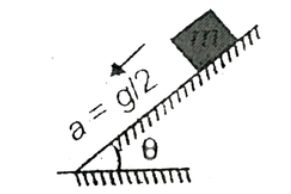A copper cube of mass 200g slides down an a rough inclined plane of inclination 37∘ at a constant speed. Assume that any loss in mechanical energy goes into the copper block as thermal energy .Find the increase in the temperature of the block as it slides down through 60cm. Specific heat capacity of copper =420Jkg−1K−1
The correct Answer is:A, C
To solve the problem, we need to find the increase in temperature of a copper cube sliding down a rough inclined plane. Here are the steps to arrive at the solution:
Step 1: Understand the Given Data
- Mass of the copper cube (m) = 200 g = 0.2 kg (conversion from grams to kilograms)
- Inclination angle (θ) = 37 degrees
- Distance slid down the incline (L) = 60 cm = 0.6 m (conversion from centimeters to meters)
- Specific heat capacity of copper (S) = 420 J/(kg·K)
Step 2: Calculate the Change in Potential Energy
The change in potential energy (ΔPE) as the block slides down can be calculated using the formula:
ΔPE=m⋅g⋅h
where h is the vertical height descended, which can be calculated as:
h=L⋅sin(θ)
Substituting the values:
- g (acceleration due to gravity) is approximately 10m/s2
- h=0.6⋅sin(37∘)
Using sin(37∘)≈0.6:
h=0.6⋅0.6=0.36m
Now, substituting the values into the potential energy formula:
ΔPE=0.2⋅10⋅0.36=0.72J
Step 3: Relate Change in Potential Energy to Thermal Energy
According to the problem, the loss in mechanical energy (decrease in potential energy) is converted into thermal energy gained by the copper block:
ΔPE=ΔQ
where ΔQ is the thermal energy gained.
Step 4: Use the Formula for Thermal Energy
The thermal energy gained is given by:
ΔQ=m⋅S⋅ΔT
where ΔT is the increase in temperature.
Setting the two expressions for energy equal:
0.72=0.2⋅420⋅ΔT
Step 5: Solve for Increase in Temperature (ΔT)
Rearranging the equation to find ΔT:
ΔT=0.720.2⋅420
Calculating the denominator:
0.2⋅420=84
Now substituting back:
ΔT=0.7284≈0.00857K
Step 6: Final Answer
Thus, the increase in temperature of the copper block is approximately:
ΔT≈0.00857K
- Mass of the copper cube (m) = 200 g = 0.2 kg (conversion from grams to kilograms)
- Inclination angle (θ) = 37 degrees
- Distance slid down the incline (L) = 60 cm = 0.6 m (conversion from centimeters to meters)
- Specific heat capacity of copper (S) = 420 J/(kg·K)
The change in potential energy (ΔPE) as the block slides down can be calculated using the formula:
ΔPE=m⋅g⋅h
where h is the vertical height descended, which can be calculated as:
h=L⋅sin(θ)
Substituting the values:
- g (acceleration due to gravity) is approximately 10m/s2
- h=0.6⋅sin(37∘)
h=0.6⋅0.6=0.36m
ΔPE=0.2⋅10⋅0.36=0.72J
According to the problem, the loss in mechanical energy (decrease in potential energy) is converted into thermal energy gained by the copper block:
ΔPE=ΔQ
where ΔQ is the thermal energy gained.
The thermal energy gained is given by:
ΔQ=m⋅S⋅ΔT
where ΔT is the increase in temperature.
0.72=0.2⋅420⋅ΔT
Rearranging the equation to find ΔT:
ΔT=0.720.2⋅420
Calculating the denominator:
0.2⋅420=84
Now substituting back:
ΔT=0.7284≈0.00857K
Thus, the increase in temperature of the copper block is approximately:
ΔT≈0.00857K
Topper's Solved these Questions
- BOOK - DC PANDEY ENGLISHCHAPTER - CALORIMETRY & HEAT TRANSFEREXERCISE - Level 2 More Than One Correct5videos
CALORIMETRY & HEAT TRANSFER
- BOOK - DC PANDEY ENGLISHCHAPTER - BASIC MATHEMATICSEXERCISE - Exercise13videos
BASIC MATHEMATICS
- BOOK - DC PANDEY ENGLISHCHAPTER - CALORIMETRY AND HEAT TRANSFEREXERCISE - Medical entrance s gallery38videos
CALORIMETRY AND HEAT TRANSFER
Similar Questions
A copper cube of mass 200g slides down an a rough inclined plane of inclination 37∘ at a constant speed Assume that any loss in mechanical energy goes into the copper block as thermal energy .Find the increase in the temperature of the block as if slides down through 60cm Specific head capacity of copper =420Jkg−1K−1
View SolutionA block of mass m slides down a rough inclined plane with an acceleration g2
 View Solution
View SolutionCalculate the amount of heat energy required to raise the temperature of 100 g of copper from 20∘C to 70∘C. Specific heat capacity of copper = 390 J kg−1K−1
View SolutionA ball is dropped on a floor from a height of 2.0m After the collision it rises up to a height of 1.5m. Assume that 40% of the mechanical energy lost goes as thermal energy into the ball. Calculate the rise in the temperature of the ball in the collision specific heat capacity of the ball is 800Jkg−1K−1
View SolutionA copper block of mass 60kg is heated till its temperature is increased by 20∘C . Find the heat supplied to the block. Specific heat capacity of =0.09calg−1−C.
View SolutionA block of mass 250 g slides down an incline of inclination 370 with a uniform speed. Find the work done against the friction as the block slides through 1.0 m.
View SolutionA block slides down on inclined plane (angle of inclination 60∘ ) with an accelration g/2 Find the coefficient friction
 View Solution
View SolutionA block of mass 1 kg slides down a rough inclined plane of inclination 60∘ starting from its top. If coefficient of kinetic is 0.5 and length of the plane d=2 m, then work done against friction is
View SolutionA ball is dropped on a floor from a height of 2.0m. After the collision it rises up to a height of 1.5m. Assume that 40% of the mechanical energy lost goes as thermal energy into the ball.Calculate the rise in the temperature of the ball in the collision. Heat capacity of the ball is 800JK−1
View SolutionA copper block of mass 0.06 kg is heated till its temperature is inreased by 20∘C. Find the heat supplied to the block. [specific heat of copper=9×10−2calg−1.∘C−1]
View Solution

